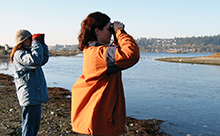Welcome!
 Find out more about this unique ecosystem and how you can help protect it.
Find out more about this unique ecosystem and how you can help protect it.
Check out the iNaturalist and eBird Canada listings for Esquimalt Lagoon.
Learning more about Esquimalt Lagoon
Many groups are involved in research and restoration at Esquimalt Lagoon. Learn more about forage fish monitoring programs, bird studies, and plans for restoration and climate adaptation in this video showcasing speakers from the Victoria Natural History Society’s Natural History Night.
Greater Victoria's Migratory Bird Sanctuaries
 ELSI, GWI, and several other regional conservation partners collaborated in 2017 to celebrate the 100th anniversary of the Migratory Bird Convention Act. The goals were to improve stewardship of the ecosystems that support birds and other wildlife in our urban centres, and to raise awareness of the 3 sanctuaries in the CRD. A brochure was developed to highlight the unique features of our three local bird sanctuaries:
ELSI, GWI, and several other regional conservation partners collaborated in 2017 to celebrate the 100th anniversary of the Migratory Bird Convention Act. The goals were to improve stewardship of the ecosystems that support birds and other wildlife in our urban centres, and to raise awareness of the 3 sanctuaries in the CRD. A brochure was developed to highlight the unique features of our three local bird sanctuaries:
Learn more about our region's three Migratory Bird Sanctuaries through this
video.
Greater Victoria NatureHood
The Greater Victoria NatureHood is a collaboration of local non-profit, private and public organizations that work together to connect residents and visitors to nature found in and around the capital region, for the purposes of nature conservation, preservation, and restoration. One of NatureHood's goals is to celebrate the capital region's three Migratory Bird Sanctuaries, among the many other natural treasures in Greater Victoria. The Greater Victoria NatureHood map has been created tell the stories of urban habitats, local species, and special natural areas through the region. Esquimalt Lagoon is profiled on the map, along with numerous other natural areas to explore.
European Green Crab Monitoring:
The invasive European Green Crab (EGC) has recently been found in Esquimalt Lagoon through a monitoring program led by Fisheries and Oceans Canada (DFO). The EGC is of concern because it has the potential to destroy eel grass meadows, which are important nursery habitat for herring and salmon. The crabs also eat local clams, oysters, and mussels, and compete with other native crabs.
The DFO is asking for the public to watch for the invasive crab while at Esquimalt Lagoon and in other marine areas around Southern Vancouver Island. The EGC is often green, though not always. Its main distinguishing feature are five spines beside each eye.
If you see a European Green Crab, check the information on how to report it. Members of the public are asked to submit a photograph, GPS location, date, and description of distinguishing features.
The DFO also runs a training and monitoring program for ELSI volunteers to help watch for EGCs in the lagoon. For more information please contact the ELSI coordinator.